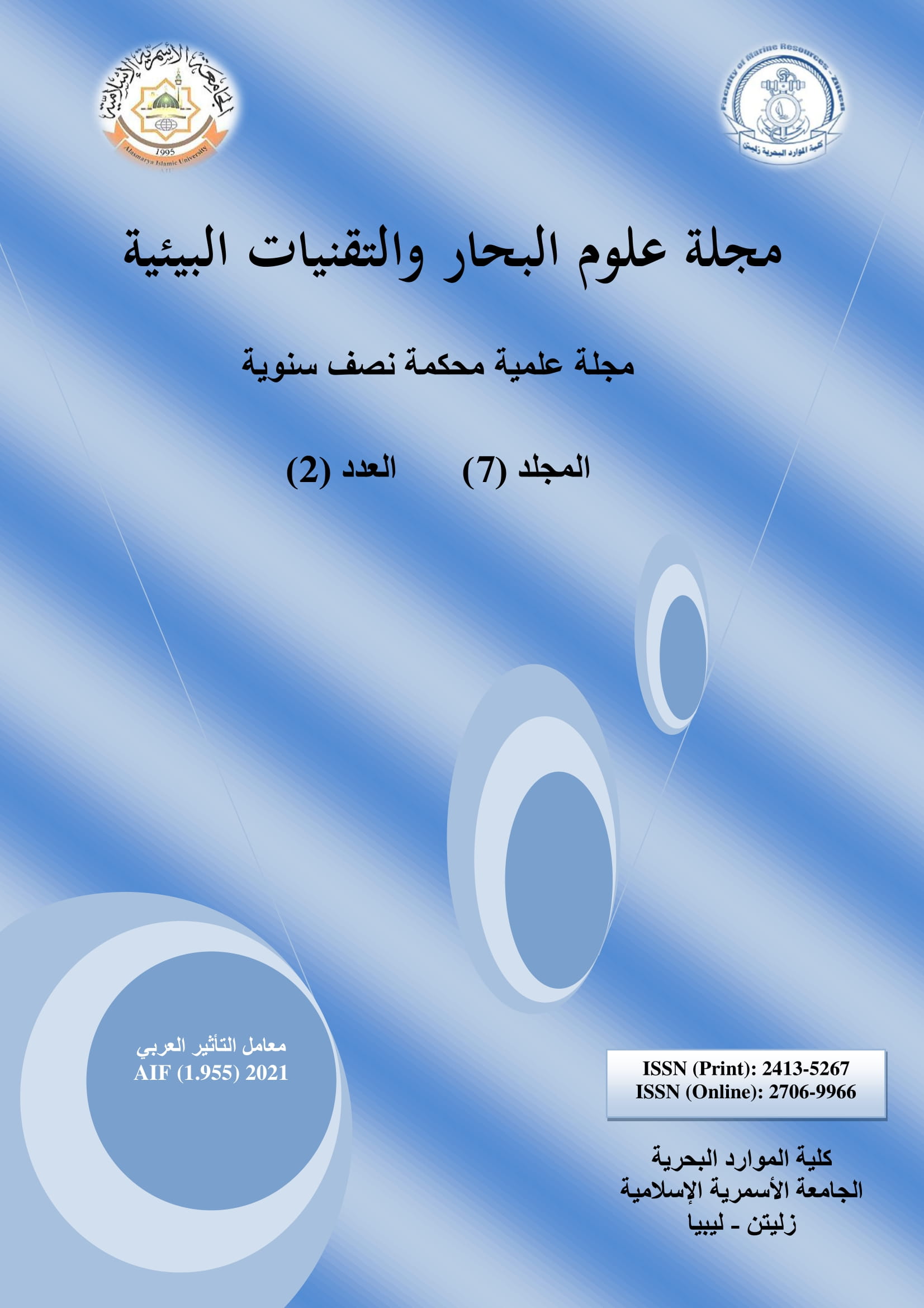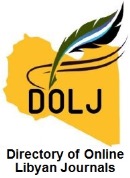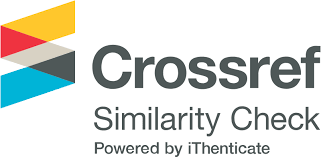استعراض الآثار المحتملة للانسكابات النفطية على الموارد الساحلية والبحرية على الساحل الغربي الليبي
DOI:
https://doi.org/10.59743/jmset.v7i2.14الكلمات المفتاحية:
تسرب النفط، موارد بيولوجية، الساحل الغربي الليبي، حساسية التسرب النفطي، الموارد الاجتماعية والاقتصاديةالملخص
يمكن أن يؤثر الانسكاب النفطي بشكل كبير على الموارد الساحلية والاقتصادية من خلال الأنشطة الاقتصادية التي تعتمدفى عملها على مياه البحر النظيفة والمناطق الساحلية والمواقع السياحية مما قد يتسبب في خسائر اقتصادية كبيرة بعد الانسكابات النفطية. ومع ذلك، يعتمد هذا التأثير عادة على حجم ونوع الانسكاب النفطي ومدى حساسيته للموارد الساحلية والبحرية. ليبيا لديها واحدة من أهم النقاط الساخنة للتنوع البيولوجي البحري في البحر الأبيض المتوسط وهو الساحل الغربي الليبي الذي يمتد من غرب مدينة طرابلس إلى خليج قابس مع تونس. يأخذ هذا العمل في الاعتبار بعض تأثيرات الانسكابات النفطية على مجموعة متنوعة من الصناعات الساحلية والأنشطة الاجتماعية. بالإضافة إلى ذلك، يوفر هذا العمل مراجعة منهجية للأدبيات الخاصة بالموارد البيولوجية والاقتصادية والثقافية وحساسيتها لسيناريوهات الانسكاب النفطي على هذا الساحل. تساعد نتائج هذا العمل على توفير أساس لتحديد أولويات الحماية لتطوير القدرة على الاستجابة للانسكابات النفطية على السواحل الليبية.
التنزيلات
المراجع
African World Heritage sites. (2020). Available online at: [https://www.africanworldheritagesites-.org/cultural-places/frontiers-of-the-roman-empire/sabratha.html]. Accessed on: 10/2/2020.
Ahwide F. and Aldali Y. (2014). The current situation and perspectives of electricity demand and estimation of carbon dioxide emissions and efficiency. International Journal of Environmental and Ecological Engineering, 7(12): 979-984.
Badi I., Ballem M., and Shetwan A. (2018). Site selection of desalination plant in Libya by using combinative distance-based assessment (CODAS) method. International Journal for Quality Research, 12(3).
Brika B. (2018). Water resources and desalination in Libya: A review. In: Multidisciplinary Digital Publishing Institute Proceedings, 2(11): 586.
Bureau of Statistics and Census Libya (2021). Available online at: [ http://www.bsc.ly/downloars-_file.php?Id=144]. Accessed on: 22/1/2021.
Casale P., Broderick A.C., Camiñas J.A., Cardona L., Carreras C., Demetropoulos A., and Türkozan, O. (2018). Mediterranean sea turtles: current knowledge and priorities for conservation and research. Endangered Species Research, 36: 229-267.
Casale P., Hochscheid S., Kaska Y., and Panagopoulou A. (2020). Sea turtles in the Mediterranean Region. MTSG Annual Regional Report 2020. Report of the IUCN-SSC.
Doan Q.T. (2015). Application of Environmental Sensitivity Index Map for Coastal Oil Spill Incident Response Case Study of Cat Ba Island, Vietnam. PhD dissertation, Department of Environmental Engineering, Da-Yeh University, China.
EGA-RAC/SPA Waterbird Census Team. (2012). Atlas of Wintering Waterbirds of Libya, 2005–2010. Tunis: Imprimerie COTIM. Available online at: [http://www.isprambiente-.gov.it/files/pubblicazioni/pubblicazionidipregio/Atlas_of_wintering_waterbird_in_Libya_20052010.pdf].
Eiser W.C. and Kjerfve B. (1986). Marsh topography and hypsometric characteristics of a South Carolina salt marsh basin. Estuarine, Coastal and Shelf Science, 23595-23605.
Elferjani I. and Ghashat H. (2017). Enhancing the performance of Libya's Ports: An investigation of local stakeholders’ experience. IAME 2017 CONFERENCE | KYOTO, JAPAN IAME Paper ID 890.
Etayeb K.S., Taboni E., and Essghaier M.F. (2012). Aspects on Libyan Legislation for Biodiversity conservation and propose Farwa complex as protected area. 2nd Djerba International Mediterranean Environment Sustainability Conference, Vol. XI: 81-90
Filogh A. (2019). Libya Fishing Industry. Menba Kastamonu Üniversitesi Su Ürünleri Fakültesi Dergisi, 5(1): 16-26.
Finzi C.V. (1969). The Mediterranean Valleys: Geological Changes in Historical Times. Cambridge University Press.
GECOL-General Electricity Company of Libya (2017). TASK C – REPORT 4.2: IMPROVING GECOL TECHNICAL PERFORMANCE.
Hamza A. (2010). Sea turtles in the Mediterranean Sea: distribution, threats and conservation priorities. IUCN, Gland, 157−170.
Helm R.C., Costa D.P., DeBruyn T.D., O’Shea T.J., Wells R.S., and Williams T.M. (2015). Overview of effects of oil spills on marine mammals. Handbook of oil spill science and technology. John Wiley & Sons, Hoboken, NJ.
Incardona J.P., Collier T.K., and Scholz N.L. (2011). Oil spills and fish health: exposing the heart of the matter. Journal of exposure science & environmental epidemiology, 21(1): 3-4.
IPIECA-IOGP (2015). Impacts of oil spills on marine ecology. IPIECA-IOGP Good Practice Guide Series, Oil Spill Response Joint Industry Project (OSR-JIP). IOGP Report 525. Available online at: [http://oilspillresponseproject.org].
ITOPF (2011). Effects of oil pollution on social and economic activities. The International Tanker Owners Pollution Federation, ITOPF Technical Information, UK, Paper ID: 12.
IUCN (2011). Towards a Representative Network. Available at of Marine Protected Areas in Libya. Available online at: [https://www.cbd.int/doc/meetings/mar/ebsaws-2014-03/other/ebsaws-2014-03-submission-iucn-04-en.pdf]. Accessed on: 22/11/2019
Kankara R.S. and Subramanian B.R., (2007). Oil spill sensitivity analysis and risk assessment for Gulf of Kachchh,India, using integrated modeling. Journal of Coastal Research, 23(5): 1251–1258.
Labelle, R.P., Rainey, G., Lanfear, K.J., (1982). An Application of a Vulnerability Index to Oil Spill Modeling in the Gulf of Mexico. US Geol. Surv.
Laurent L., Bradai M.N., Hadoud D., El Gomati H.M., and Hamza A. (1999). Marine turtle nesting activity assessment on Libyan coasts. Phase 3: survey of the coast to the west of Misratah. Mar. Biol. Res., 35.
Liu P., Li Y., Xu J., and Wang T. (2019). Oil spill extraction by X-band marine radar using texture analysis and adaptive thresholding. Remote Sensing Letters, 10(6): 583-589.
Maitieg A., Lynch K., and Johnson M. (2018). Coastal Resources Spatial Planning and Potential Oil Risk Analysis: Case Study of Misratah’s Coastal Resources. Conference: 19th International Conference on Geography and Environmental Studies, Libya.
Mendelssohn I.A., Andersen G.L., Baltz D.M., Caffey R.H., Carman K.R., Fleeger J.W., and Rozas L.P. (2012). Oil impacts on coastal wetlands: implications for the Mississippi River Delta ecosystem after the Deepwater Horizon oil spill. BioScience, 62(6): 562-574.
Milanese M., Sarà A., Manconi R., Abdalla A.B., and Pronzato R. (2008). Commercial sponge fishing in Libya: Historical records, present status and perspectives. Fisheries Research, 89(1): 90-96.
National Geographic (2021). Available online at: [https://www.nationalgeographic.com/news/2010-/5/102705-energy-oil-spill-risks-gulf-power-plants/]. Accessed on: 20/11/2021.
National Oil Corpoation (NOC) (2021). Available online at: [https://noc.ly/index.php/en/]. Assessed on: 15/02/2021.
Naz S., Iqbal M.F., Mahmood I., and Allam M. (2021). Marine oil spill detection using Synthetic Aperture Radar over Indian Ocean. Marine Pollution Bulletin, 162: 111921.
NOAA NRDA. Gulf Dolphins Questions and Answers. Available online at: [http:// www.gulfspill-restoration.noaa.gov/2012/03/gulfdolphinsanswers]. Accessed on: 12/2/2020.
NOAA. National Oceanic and Atmospheric Administration. Available online at: [https://www.-fisheries.noaa.gov/national/habitat-conservation/coastal-wetlands-too-valuable-lose]. Accessed on: 15/2/2021.
Oliveira E.R., Silveira B., and Alves F.L. (2014). Support mechanisms for oil spill accident response in costal lagoon areas (Ria de Aveiro, Portugal). Journal of sea research, 93: 112-117.
Onofri L., Nunes P.A.,and Bosello F. (2013). Economic and climate change pressures on biodiversity in southern Mediterranean coastal areas. MEDPRO Technical Paper, (24).
Reddy C.M., Arey J.S., Seewald J.S., Sylva S.P., Lemkau K.L., Nelson R.K., and Camilli, R. (2012). Composition and fate of gas and oil released to the water column during the Deepwater Horizon oil spill. Proceedings of the National Academy of Sciences, 109(50): 20229-20234.
Stokes K.L., Broderick A.C., Canbolat A.F., Candan O., Fuller W.J., Glen F., and Godley B.J. (2015). Migratory corridors and foraging hotspots: critical habitats identified for Mediterranean green turtles. Diversity and Distributions, 21(6): 665-674.
Temehu (2021). Available online at: [https://www.temehu.com/Cities_sites/abu-kammash.html]. Accessed on: 10/2/2020.
The Mediterranean Protected Areas Network (MedPan). Available online at: [https://medpan.org/conservation-of-sea-turtles-and-their-habitats-in-the-island-of-farwa/].Accessed on: 10/01/2021.
UNEP. Available online at: [http://web.unep.org/unepmap/]. Accessed on: 15/10/2021.
UNEP/MAP (2012). State of the Mediterranean marine coastal environment. Available online at: [https://www.eea.europa.eu/data-and-maps/indicators/nutrients-in-transitional-coastal-and-4/unep-map-2012-initial-integrated.8]. Accessed on: 22/2/2021.
UNESCO (2021). Available online at: [https://whc.unesco.org/en/list/184]. Accessed on: 22/2/2021.
التنزيلات
منشور
إصدار
القسم
الرخصة
الحقوق الفكرية (c) 2021 مجلة علوم البحار والتقنيات البيئية

هذا العمل مرخص بموجب Creative Commons Attribution 4.0 International License.












